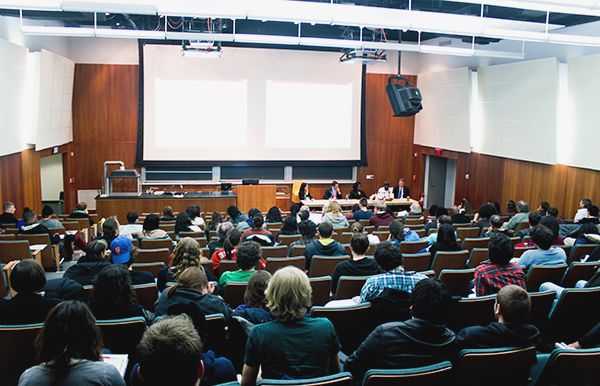
A symposium was held on the New York Police Department’s (NYPD) stop-and-frisk policy on Dec. 5 at 4:30 p.m. in the Coykendall Science Building Auditorium.
The symposium featured several speakers, including Gabriel Sayegh, state director of Drug Policy Alliance (DPA); Chino Hardin, a community organizer from the Institute for Juvenile Justice Reform and Alternatives; Alfredo Carrasquillo, an organizer from VOCAL-NY; and Andrew Kossover, head of the Ulster County Public Defender’s Office, according to the event page on Newpaltz.edu.
The symposium was hosted by the Sociology Department and cosponsored by the Black Studies Department, the Latin American and Caribbean Studies Department, Student Association (SA), Black Student Union, Amnesty International and Students for a Sensible Drug Policy, the event page said. Assistant Professor of Sociology Alexandra Cox, who started teaching at New Paltz at the start of the semester, began organizing the symposium in September after creating an assignment for her Crime and Society class.
“I started organizing the symposium to complement both the work I was doing in the class but also to create an opportunity for the broader student body to think about how this issue might affect them, in part because so many young people are pulled over by the police and a lot of young people from this college have experienced stop-and-frisk,” Cox said.
Cox said she previously worked for the DPA in New York City, which has been working on the issue of stop-and-frisk. SA Executive Vice President Manuel Tejada said the New York Civil Liberties Union (NYCLU), the American Civil Liberties Union (ACLU) and the Center for Constitutional Rights are among organizations that have all “put out cases in redress to this issue.”
According to their website, Nyclu.org, the NYCLU has several open court cases surrounding the stop-and-frisk policy. The organization, a chapter of the ACLU, also released a report on stop-and-frisk in 2011 and offers updates on current statistics, NYPD reports, campaigns and court cases on the website.
Tejada, who has worked for the NYCLU, said the practice is “very controversial, very discriminatory and racially motivated.” He said stop-and-frisk usually affects young people between the ages of 18 and 25, and about 85 percent of people stopped are Black or Latino. The statistic remains consistent across data from the past nine years gathered by the NYCLU, which is available on their website.
Tejada said the policy works under a reason of suspicion clause—meaning police officers can stop, question and frisk anyone they believe may have committed, or will commit, a crime—which leaves enforcement of the policy open to interpretation. He said although the policy does not officially work on a quota system, there is pressure for police offers to fill out stop-and-frisk forms, and that NYPD Commissioner Ray Kelly and Mayor Bloomberg are “hell bent” on keeping the policy in place.
“The New York Times has done extensive coverage,” Tejada said. “They’ve done extensive coverage interviewing people who have been stopped multiple times—people who are innocent, people who say they feel that it’s become a common practice in their lives to be just stopped and then randomly frisked. You know, it creates disdain, it creates more aggression towards police, it creates more fear towards police. It doesn’t actually create community or create a safer community.”
Both Tejada and the NYCLU said nine out 10 people stopped and frisked are innocent. Many times the only thing police officers find during a stop-and-frisk is marijuana. Tejada said Commissioner Kelly made a direct order in September of 2011 stating that people stopped with small amounts of marijuana should not be arrested, but that those arrests continue to be made — even with Gov. Cuomo’s recent push for decriminalization laws in the state.
Cox said the symposium would include presentations by speakers on both the policy and community organizing efforts against it.
“The symposium will represent all of the perspectives,” she said. “So we have two amazing community organizers who are coming to talk about the work that they’ve been doing on the ground with people who have been affected by the policy, and then we have someone from the Drug Policy Alliance who’s been working on the policy end to try to shift the policy itself through legislative channels or through advocating with elected officials about it.”
The presentations would be kept at five to 10 minutes to allow more time for a forum between students and speakers, Cox said, and a reception would follow.
Cox said she and Tejada have discussed organizing a teach-in surrounding stop-and-frisk, which Cox described as a “more focused, action-oriented event in which students can have a chance to think through how they might be able to work on the issue.” Cox said she has also spoken with people from the DPA on how to work with students on stop-and-frisk.
“The forum could be a way of building student support for the issue,” she said. “As it exists now, there are several student organizations that are really excited about this issue…so I think they want to work on it as a campaign issue anyway. So this forum’s just a chance to learn more about the issue but also…equip students with practical ideas about organizing around the issue.”
Tejada stressed that the stop-and-frisk policy is relevant to everyone.
“As more people know about it, more people are educated about it,” he said. “Whether you get stopped and frisked all the time, or you don’t get stopped and frisked at all, knowing about that, knowing about this issue is [really important] because it affects communities and it affects communities that are around us…You know, sexual abuse exists. Racism exists. All these forms of marginalization and forms of oppression do exist and a lot them [are] systematic, a lot of it isn’t, so these conversations need to be had.”

